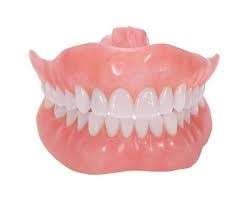


These are removable appliances that simulate the look and function of the tooth and its surrounding tissue. While complete dentures are indicated for patients with total loss of teeth, partial dentures are for patients missing one or few teeth
Dentures can also be fixed now by use of dental implants(Implant supported Overdenture).

This is the least expensive of all the dentures. These are generally used for temporary or intermediary purpose until the final prosthesis is made.
Another common and infact more important use of these appliances is as an “immediate partial denture”. This means that the appliance can be made before the teeth are removed, and inserted immediately after the extraction of the planned teeth so that the patient is never without teeth. This is of special help when anterior teeth are to extracted and patient wants to return back to his/her normal routine immediately. It has following disadvantages :
These Dentures are cast metal frameworks made of chrome cobalt. These are cast very thin and are much less likely to break than the all plastic variety. For the same reason they are much less noticeable to the tongue
These Dentures are cast metal frameworks made of chrome cobalt. These are cast very thin and are much less likely to break than the all plastic variety. For the same reason they are much less noticeable to the tongue. It has following advantages :
The flexibility, combined with strength and light weight, provides total comfort and great looks! It is nearly unbreakable, is colored pink like the gums, can be built quite thin, and can form not only the denture base, but the clasps as well.

The Valplast® partial is virtually invisible because there are no metal clasps and the material itself blends with the tissue in your mouth so that the only thing that shows is your beautiful smile.
Durable long-term performance
Valplast® appliances are very durable and are designed to give long term performance under normal usage. Small accidents such as dropping the appliance in the sink or on the floor will not damage the Valplast®.